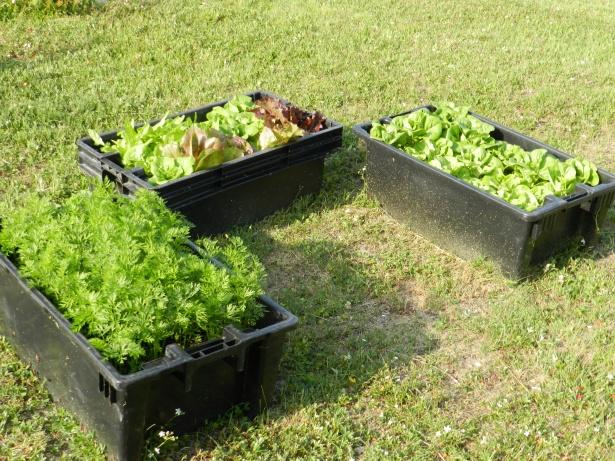Reader Question: I have access to a cattleman's large stack of empty plastic lick tubs and would like to use those to plant some of my garden. They are about 2' across and about that deep. I was thinking of putting my vine crops (pumpkins, squash, cantaloupe and watermelon) in individual tubs. Will they produce in a tub if I put holes in the bottom for drainage and use compost for the growing medium? The city has compost for sale and we were thinking of getting some of that, but they don’t show a soil analysis online so I’m not sure if it would be safe to use just that or try to mix it. They do offer the percent of each product that they have included in the compost mix: 45% leaves/grass clippings, 30% branches, 15% manure and 10% biodegradable oils. Do you think we could use a straight mix of this compost in the tubs? Also will these cross pollinate if I have them too close? Are there any vegetables that would NOT grow well in tubs?
Answer: Yes, you can certainly grow vegetables in those containers! See the following tips to learn more about growing a vegetable garden in plastic containers.
Container Garden Tips

Container Selection
Usually the biggest concern in growing vegetables in containers is having large enough containers so that they do not dry out too quickly. These tubs should work well. However, I would suggest you look for “bush type” varieties of the vegetables you mention because the regular type can get pretty big and may still cause a watering issue. Once the plants get good sized, you may need to water several times a week to keep up with the water needs of those big vines. Be sure that you add sufficient water to saturate the container full of soil and some of it drains out of the drainage holes.
Make sure the containers you use are cleaned out well so there is none of the salt residue left in them. I would probably make about six good sized holes in them to allow for drainage.
Growing Medium
You mention using compost as the growing medium. Compost is good but depending on its composition, it might be better to mix it with potting soil, it could be too high in salts to use it straight. I would suggest you contact them to see if they have any soil analysis reports that they could share with you. I would be most interested in the soluble salts content of the media. If that is too high, you will need to mix it with potting soil. Some people have access to composted cattle manure. I would only use about 10%, with the rest potting soil because it can be quite high in soluble salts and nitrogen. The high salts can burn the roots of your plants and If you have too much nitrogen your cucurbits will mostly grow vines with few fruit. Field or garden soil could be used but you need to be careful of herbicide residue. I would also suggest you mix in about 50% peat moss or perlite to lighten the mix of garden soil and improve aeration.
Cross Pollination
You really don’t have to worry about cross pollination between the different vegetables you mention. Melons will not cross-pollinate with pumpkins or squash. Even if the melons were to cross with each other, it would not affect the fruit. You would only really see the results of the cross if you saved seed from those fruit and planted them again next year. However, cucurbits like these produce separate male and female flowers on the same plant so it would be good to have several plants of each to better assure the chances for pollination by bees between the male and female flowers of each species.
Vegetable Varieties
You can grow lots of other vegetables in tubs like this. The important things to remember are using a good growing medium and keeping enough water on the plants as they get larger. Now there are even some sweet corn varieties that are developed for container growing.


